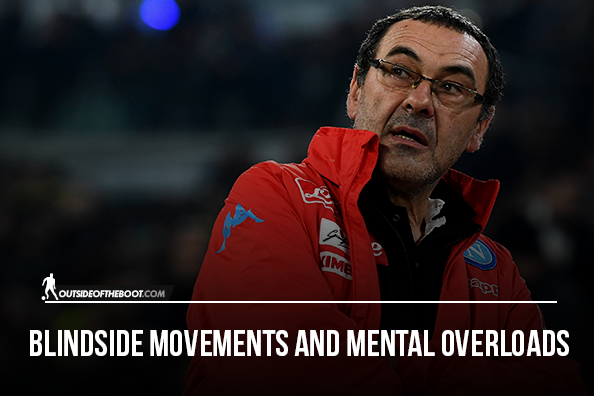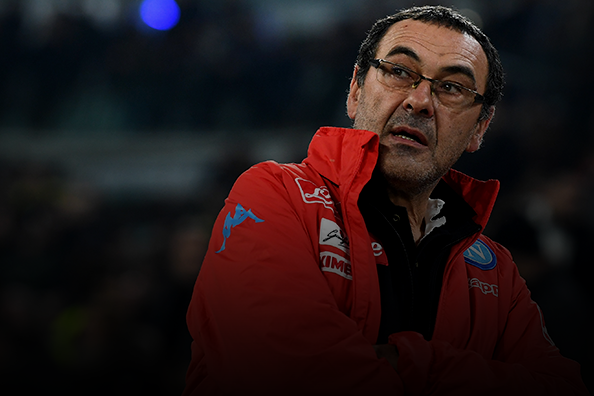Cheuk Hei Ho breaks down Maurizio Sarri’s tactics at Napoli looking at how the Italian giants use passing, blindside movements, and mental overloads to overcome the opposition.

When you watch Napoli’s games under Maurizio Sarri, one thing that will jump to your mind is that they play a lot of passes, especially short passes. Napoli passed 11.5 times per percentage of possession last season, leading all 134 teams in the top flight of seven leagues in Europe (Bundesliga, Eredivisie, La Liga, Liga NOS, Ligue 1, Premier League, and Serie A). They play 28% more passes per possession than average (8.6) in these seven leagues. The number jumps to 39% if we only measure short passes. Interestingly, Napoli used very few dribbles: they dribbled once about every 40 passes, a number that ranks them 4th lowest among 134 teams. Therefore, Napoli used a lot of short passes without needing to dribble the ball to create chances.
Jorginho’s position during the build-up
Jorginho plays as the central defensive midfielder in Sarri’s system. Last season Jorginho shared this position with Amadou Diawara. Diawara is more physical and a better defensive player while Jorginho is a better passer.
Both players can send dangerous vertical passes forward if not marked. The following breakdown focuses on Jorginho, but applies to Diawara as well.
Napoli often sets up their offensive phase through gradual build-up. Both Raul Albiol and Kalidou Koulibaly can carry the ball forward. The midfielders, especially Jorginho, are their primary pass target. When the center backs have the ball, Jorginho often occupies a strategic position and places himself slightly behind the opponent’s first line of defense:
Many teams that focus on possession-based football often have their central defensive midfielder to drop in-between the two center backs to facilitate build-up (such as Pep Guadiola’s teams). Napoli is unusual in that the central defensive midfielder almost never drops to the same line as the center backs. The idea for Jorginho’s position is that by positioning himself behind the opponent’s first line of defense, he is often in their blindsides, making it very difficult for them to cover him using their covershadows. If the opponent wants to cut off the passing lane towards him, they have to either use the first or second line of the defense to chase Jorginho:
If the opponent’s strikers focus on marking Jorginho, they basically give up their first line of the defense. Albiol and Koulibaly can often find clear passing lanes upfront, or carry the ball upward. Another option for Napoli is to have other midfielders like Marek Hamsik or Allan to drop back to receive the ball. If the opponent uses their midfielders to pressure Jorginho, they will leave a lot of the space behind, making it very easy for Napoli to exploit.
Napoli’s 2-5 or 3-4 shape during the initial build-up
Another way that Napoli builds up their offensive phase is to generate overloads with the four defenders and three midfielders. Napoli always lines up in a 4-3-3 formation, but their back seven players rarely play in the 4-3 configuration in the offensive phase. Instead, they often play in a 2-5 or 3-4 shape:
In the 2-5 configuration, both full backs will push up to the midfield and form a 5-men midfield to maximize the width of the attack. In the 3-4 configuration, the full-back on the ball-close side will push up to the midfield while the full-back on the opposite side will drop back with the two center backs to create a back-three to maximize passing lanes. The three-midfielders are critical during the build-up. Just like Jorginho uses his positions to confuse and distort the opponent’s lines of defense, Napoli’s three midfielders often stay very close to each other and operate in the spaces between the opponent’s first and second line of defense. They can either lure or overload the opponent’s defenders.
Insigne’s blindside movement
Compared to Jose Callejon and Dries Mertens, Lorenzo Insigne is a more important piece in Napoli’s build-up. Mertens is the striker and Callejon is a classical winger. Both players mostly connect the ball on the last few passes in the chance creation. Insigne, on the other hand, often switches position with his teammates during the build-up. He is an inverted winger and often drifts inside. Moreover, Napoli’s most successful way to penetrating the opponent’s defense is to use the left flank, with the combinations between Faouzi Ghoulam, Hamsik, and Insigne. Like most of Napoli’s players, Insigne mostly operates in the space between the lines. However, he is their best player in utilizing blindside of the defenders:
Fake-run
Napoli’s players are always moving in the offensive phase. This article summarizes some of the positional rotation concepts they use to open the opponent’s defense. Here I break down another concept that Sarri uses with his players’ movement: fake-run.
It is unlikely that Napoli’s players deliberately decide when to do a fake-run or a real-run. What they have in mind during a game is to move constantly and the players only look for an open passing lane in different scenarios. One important point to note is that Napoli’s players most often move vertically but not horizontally without the ball (other than when the wingers moved centrally to release the full-backs). Moreover, they also often operate in the space between the lines. Again, this set-up allows them to take advantage of the blindside of opponent’s players. The opponents always face Napoli player’s movements and have to make decisions on whether to defend/chase/tackle a player or not at a frequency more than they used to. The end result is that the opponent often loses the defensive shape they prefer.
The discussion above focuses on players’ movements while the following discussion focuses on how Napoli uses the passes very differently from 99% of the teams in Europe. The way they use passes is the reason why Sarri is one of the most innovative, if not the most innovative coach in the world.
Pass to diffuse pressure
These quick exchanges of short passes between Napoli’s players do not look practical on the surface, but they are important for Napoli to advance the players: Imagine when a player carries the ball forward by himself. A defender will be willing to tackle a player carrying the ball by himself. However, when a player advances the ball by Napoli’s way of quick pass exchange, at least two defenders need to commit to mark them in order to mount a successful tackle. This tactic is a way for Napoli to advance the ball while minimizing the pressure upon their players.
Pass to speed up the game
Napoli uses passes to minimize dribbling. Dribbling is hard compared to passes: The average dribble success rate in Serie A last season is about 61% while the success rate of short passes is about 85%. Moreover, dribbling is slow. Just think about the how long it takes for a player to run with vs. without the ball. In other words, these short passes increase the speed of Napoli’s attack.
Second passer as a facilitator
Napoli play a lot of backward passes. The goal of these passes is to find and use a second passer / facilitator that has a better passing range to facilitate ball progression. They often use the center backs or Jorginho (who is similar to the center backs and often positions behind the other players). The improved passing range is generated by the wider angle these players enjoy. These extra passes also produce a temporal window where other Napoli players can use different movements to generate passing lanes. Moreover, the constant passes produce numerous changes of the trajectory of the ball and the ball movement becomes unpredictable for the defenders to handle.
Mental overloads
This breakdown focuses on the most innovative tactic designed by Sarri.
Again, Napoli’s players plays a lot of quick short pass exchanges between each other. The idea here is that these passes are itself distractors. In psychological science, it is argued that movement per se does not attract attention, unless it is meaningful. However, in a football game, ball movement is significant. In fact, it is the most meaningful aspect of a match. A defender will almost certainly deploy some attentions to the movement of the ball. Attention is a limited resource. When you use some of it then you have less on other things. A cognitive / psychological phenomenon is called change blindness, where a change in the visual field is not detected even when the visual ability is not affected. A daily example is distracted driving: you paid less attention to driving when you are talking on the phone. The scenario of Napoli’s quick passes is very similar to this behavior. They play so many quick passes and the ball moves so fast and unpredictably that it can attract the attention of the defenders. Napoli’s players take full advantage of this temporal lack of attention to them and often find themselves unmarked in the dangerous area. This tactic is one reason why Napoli seems to be able to penetrate any team with ease.
This tactic is innovative. Take a minute and think about regular overload: Overload is a numerical advantage where the defense is overwhelmed temporally and spatially. What Napoli and Sarri are doing is to generate a “mental overload” scenario, a situation that overwhelms the defense’s cognitive / mental ability to deal with the movement of the ball and the players. Tactic like that is a spectacular display of football.
Here I tried to deconstruct Napoli’s tactics (only focus on the offensive phase) and showed why Sarri is one of the most, if not the most entertaining, innovative and creative coach in the last five years. Although I broke down their tactics individually, they are often carried out together. For example, fake-run and blindside movement can also cause confusion and can be classified as mental overload. If he continues to improve, Sarri is surely destined to be in the same class as Arrigo Sacchi and Marcello Lippi.



























































